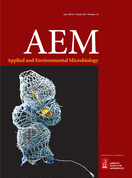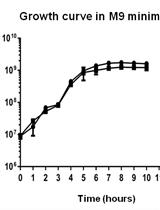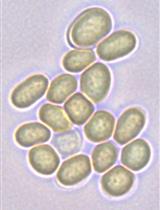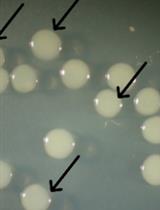- EN - English
- CN - 中文
Enriching Acidophilic Fe(II)-oxidizing Bacteria in No-flow, Fed-batch Systems
非流动、补料系统中嗜酸 Fe(II)氧化细菌的富集
发布: 2017年02月05日第7卷第3期 DOI: 10.21769/BioProtoc.2130 浏览次数: 9286
评审: Darrell CockburnAnonymous reviewer(s)
Abstract
Low-pH microbial Fe(II) oxidation occurs naturally in some Fe(II)-rich acid mine drainage (AMD) ecosystems across so-called terraced iron formations. Indigenous acidophilic Fe(II)-oxidizing bacterial communities can be incorporated into both passive and active treatments to remove Fe from the AMD solution. Here, we present a protocol of enriching acidophilic Fe(II)-oxidizing bacteria in no-flow, fed-batch systems. Mixed cultures of naturally occurring microbes are enriched from the fresh surface sediments at AMD sites using a chemo-static bioreactor (Eppendorf BioFlo®/Celligen® 115 Fermentor) with respect to constant stirring speed, temperature, pH and unlimited dissolved oxygen. Ferrous sulfate is discontinuously added to the reactor as the primary substrate to enrich for acidophilic Fe(II)-oxidizing bacteria. Successfully and efficiently enriching acidophilic Fe(II)-oxidizing bacteria helps to exploit this biogeochemical process into AMD treatment systems.
Keywords: Acid mine drainage (酸性矿井排水)Background
Low-pH microbial Fe(II) oxidation can be incorporated into AMD passive treatment systems by enhancing the development of terraced iron formations (DeSa et al., 2010; Brown et al., 2011; Larson et al., 2014a and 2014b). For extremely difficult-to-treat AMD (very low pH, very high concentrations of Fe(II) and associated metals), an active treatment bioreactor is required by enriching acidophilic Fe(II)-oxidizing bacterial communities. This process can effectively change a high acidity, high metals discharge into a moderate acidity (still low pH), low metals discharge (Sheng et al., 2016).
Acidophilic aerobic Fe(II) oxidizers Acidithiobacillus spp., Leptospirillum spp., and Ferrovum myxofaciens have all been enriched in both suspended growth and fixed-film laboratory-scale bioreactors for AMD treatment (Hedrich and Johnson, 2012; Heinzel et al., 2009a and 2009b; Janneck et al., 2010; Tischler et al., 2013). For instance, Hedrich and Johnson (2012) designed an AMD remediation system that integrated low-pH Fe(II) oxidation and Fe removal in a multi-reactor system. A pure culture of the Fe(II)-oxidizer Ferrovum myxofaciens was enriched in first suspended-growth reactor. Heinzel et al. (2009a and 2009b), Janneck et al. (2010) and Tischler et al. (2013) all developed a natural mixed community of Fe(II)-oxidizers with porous fixed-film media in a pilot-scale reactor. A protocol of enriching mixed culture acidophilic Fe(II)-oxidizing bacteria in no-flow, fed-batch systems without fixed-film media is suggested here in a chemostatic bioreactor with controlled hydrogeochemical conditions (Sheng et al., 2016).
Materials and Reagents
- Sterile plastic containers
- 0.45 μm sterile bottle-top filters (Corning, catalog number: 430514 )
- Al foil
- 50 ml sterile centrifuge tubes (VWR, catalog number: 89039-656 )
- 15 ml sterile centrifuge tubes (VWR, catalog number: 89039-664 )
- 100% N2
- 0.1% (m/v) sodium pyrophosphate (EMD Millipore, catalog number: SX0741 )
- 0.1 M sulfuric acid (H2SO4)
- 0.2 N sodium hydroxide (NaOH)
- FeSO4·7H2O (VWR, catalog number: 97061-538 )
- 1 g/L ferrozine (Thermo Fisher Scientific, Fisher Scientific, catalog number: AC410570050 )
- 50 mM HEPES (pH = 7.0) (Sigma-Aldrich, catalog number: H3375 )
- Hydroxylamine-HCl (VWR, BDH®, catalog number: BDH9236-500G )
- Bio-Rad Protein Assay Kit II (Bio-Rad Laboratories, catalog number: 5000002 )
- 10% (w/v) oxalic acid (VWR, BDH®, catalog number: BDH7336-1 )
Equipment
- Heavy-duty round carboy (VWR, catalog number: 10755-104 )
- Standard magnetic stirrer
- Fermentor (Eppendorf, BrunswickTM, model: BioFlo®/Celligen® 115 )
- pH meter
- Plate centrifuge
- Autoclave
- Freezer
- Spectrophotometer
Software
- Eppendorf BioFlo®/Celligen® 115 fermentor automatic control software
- Adobe® Photoshop® software
Procedure
文章信息
版权信息
© 2017 The Authors; exclusive licensee Bio-protocol LLC.
如何引用
Sheng, Y., Kaley, B. and Burgos, W. D. (2017). Enriching Acidophilic Fe(II)-oxidizing Bacteria in No-flow, Fed-batch Systems. Bio-protocol 7(3): e2130. DOI: 10.21769/BioProtoc.2130.
分类
微生物学 > 微生物生理学 > 适应
您对这篇实验方法有问题吗?
在此处发布您的问题,我们将邀请本文作者来回答。同时,我们会将您的问题发布到Bio-protocol Exchange,以便寻求社区成员的帮助。
Share
Bluesky
X
Copy link














